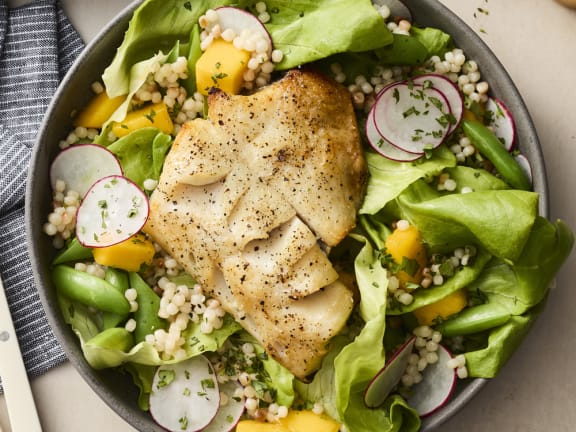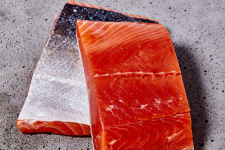
How to Cook Sablefish
March 24th, 2025What Are the Best Cooking Methods for Sablefish?
Mild sablefish is a beautiful vehicle for all kinds of flavors, from the simplest lemon squeeze and a handful of herbs to a robust, umami-packed 30-minute marinade. It can be prepared using a variety of cooking methods, depending on your culinary preferences. Cooking methods with direct or intense heat — like broiling or searing — will bring out the crispiest skin on sablefish. But gentler cooking methods can also be used to prepare this species.
Sablefish, often called black cod, is a large fish from the northeastern Pacific Ocean. Although it looks similar to Pacific cod, they’re different species with distinct flavors, body structures, and nutritional benefits.
Sablefish is one of the richest white fish, containing omega-3 fatty acids like EPA and DHA. But despite its luxurious, melt-in-your-mouth taste and texture, this fish is gloriously easy to prepare — a boon for weeknight dinners everywhere.
Here’s how to cook black cod:
Preparing Sablefish for Cooking
As you're prepareing sablefish for cooking, we recommend leaving the skin on. The fillets are quite delicate, so the skin helps to keep them intact as they cook. The skin is also where a high concentration of the fats are on a fillet, which will help the fish retain moisture as it cooks for the flakiest results. Make sure to pat the fillet dry before cooking to absorb excess moisture. Then, no matter your cooking method, consider seasoning it well with salt and pepper right before you cook to bring out the best flavor.
Sablefish can be cooked from frozen, though we recommend defrosting it first for the best texture and control over doneness. If cooking from frozen, the best method is with the air fryer.
Cooking Methods for Sablefish
Black cod can be prepared using almost any cooking method. The main thing to remember is to cook until an instant thermometer reads 135°F at the thickest part of the fillet for medium doneness, which is when it begins to flake easily with a fork. Cooking it through to 145°F is no problem, as well-done sablefish will still have a juicy, flaky quality due to its natural fat content.
-
Broil it skin side up in a flash for a crispy exterior with smoky, charred notes. Just keep an eye on it lest it turn too dark too fast.
-
Bake your sablefish for a hands-off method that celebrates its clean flavor.
-
Pan-searing creates a crispy, slightly caramelized crust. It’s fast but does require your active attention so the fish doesn’t overcook.
-
Gentle poaching is a low-effort, high-reward move if you want to preserve that delicate texture while imbuing powerful flavors.
How to Poach Sablefish
Poaching sablefish is an elegant way to cook it, and it allows this species' naturally buttery flavor to help build an intensely flavored poaching liquid.
-
Choose a pan big enough to fit the fish without crowding and small enough not to need excess liquid. Fill the pan with just enough salted water, dashi, or coconut milk to nearly submerge the sablefish.
-
Add flavorful liquids like rice vinegar, soy sauce, or citrus juice to add depth to the poaching liquid.
-
For even more flavor, aromatic elements like sliced scallions, ginger, cilantro, and fresh green chili.
-
Bring the liquid to a simmer, then add the sablefish to the pan either skin-side or flesh-side down. It should be about ¾ submerged. Reduce the heat to the barest simmer, then set a timer for 5 minutes.
-
After 5 minutes, flip the fillet and poach it for another 5 minutes or until flaky. Remove it from the heat and serve immediately.
How to Pan-Sear Sablefish
Knowing how to pan sear sablefish can help you cook up quick, dynamic meals throughout the week.
-
Make sure to pat the sablefish dry using a clean kitchen towel or paper towel to remove excess moisture from the fillet, as this can inhibit a good sear.
-
Season the fish just before cooking.
-
Heat a skillet over medium-high heat, then add a thin layer of high-heat cooking oil. When the oil is sizzling hot, carefully lower the fillet skin-side down into the skillet and press down firmly with a fish spatula for about 10 seconds to ensure good skin-to-pan contact.
-
Sear the fish undisturbed for about 4 to 5 minutes. Flip it with a fish spatula — it should release easily from the skillet — then cook the black cod for 3 to 4 more minutes until it reaches medium doneness or until it flakes easily with a fork, adding more cook time as desired to reach preferred doneness.
How to Bake Sablefish in the Oven
Baking sablefish in the oven is a hands-off way to prepare this species.
-
Pat the sablefish fillet dry with a tea towel to remove excess moisture. Allow to marinate as desired in a marinade — even something as simple as oil and lemon can add flavor.
-
Preheat oven to 400F. Arrange fillets on a baking sheet or in an oven-safe skillet, then bake for 10 minutes until thickest part of the sablefish reaches an internal temperature of 130F for medium doneness, or until it flakes easily with a fork.
-
For even more texture, turn broiler on high and broil sablefish for 2 to 3 minutes, skin-side up, for crispy skin. Remove it from the heat and serve immediately. Use this easy method to prepare sheet pan sablefish with white beans and pesto.
How to Broil Sablefish
One of the most dynamic ways to prepare sablefish is broiling it, as this method enhances the crispiness of the black cod skin and sizzling fat content of the fish. Here's how to broil sablefish:
-
Arrange top rack of oven to be 4 to 6 inches away from the broiler element, then preheat broiler to high.
-
Pat sablefish dry with a clean kitchen towel or paper towel, then season with salt and pepper. Lightly coat the black cod with a thin layer of cooking oil, then arrange skin-side down on a baking sheet.
-
Broil the fillet until it browns, flakes easily with a fork, and reaches 130F at its thickest part for medium doneness, about 8 to 10 minutes. If desired, you can flip the fillet skin-side up for the final 2 minutes.
-
Try this cooking method when making broiled miso black cod, inspired by the famous Nobu dish.
How to Store and Enjoy Leftover Sablefish
Want to know how to store and reheat cooked sablefish properly? Cooked sablefish in an airtight container will last in the refrigerator for about two days. To reheat without drying it out, gently warm it in a covered dish in a low oven, about 275F, for about 8 minutes. Alternatively, you can flake it and enjoy it chilled over a fresh salad, or toss it into a stir-fry and enjoy once its heated through.
Sustainability and Buying Tips
For the most sustainable sablefish, look of sablefish that was harvested in Alaska. Commercial fishermen catch black cod off Alaska’s coast using methods that target the species and reduce bycatch. The best quality sablefish on the market is frozen promptly after harvest, which preserves its rich texture and buttery flavor.
Be sure to source high-quality sablefish from Wild Alaskan Company. You'll receive wild-caught seafood delivered straight to your doorstep. Choose your fish membership box today.





